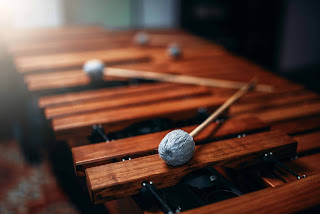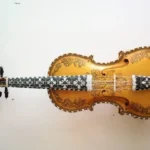
The xylophone is a musical instrument that produces sound by striking wooden bars with a mallet. The wooden bars are organized in a piano-like pattern, with each one being a different length, creating a unique sound. The xylophone is thought to have originated in ancient Southeast Asia (2000 BC) and was transported to Africa by Malayo-Polynesians. In Europe, the western xylophone, with which most people are familiar, was first referenced in 1511. At the time, it was known as ‘wooden clatter.’ The term ‘xylophone’ was not coined until the 1860s to describe the instrument.
The xylophone is an instrument that belongs to the percussion family.
Many cultures have used various variants of the xylophone for many years.
The balafon is the name for the African xylophone; the Mbilia is the name for the xylophone in Mozambique; the gyil is the name for the xylophone in Ghana, Burkina Faso, Mali, and West Africa; and the silimba is the name for the xylophone in western Zambia.
Wooden bars linked to gourds were commonly used to make early xylophones in Asia. The xylophone’s structure is now composed of wood or metal.
When Russian musician Michael Josef Gusikov travelled with his instrument in the 1800s, the xylophone gained international appeal.
The xylophone was prominent in vaudeville routines between 1910 and 1940.
Until the 1940s, when the vibraphone became increasingly prominent in this form of music, jazz musicians frequently employed the xylophone in their bands.
The xylophone became prominent in ragtime music in the 1970s.
Rosewood or Kelon are commonly used for xylophone bars (a type of fiberglass).
The xylophone is made up of different length bars that produce different sounds.
High sounds are produced by shorter xylophone bars, whereas lower notes are produced by longer xylophone bars.
A xylophone’s bars are connected together with thread or cord and held in place while vibrating when struck with a mallet to make sound.
A resonator tube is located beneath each xylophone bar and intensifies the sound.
Xylophones used in concert venues typically contain 42 to 48 hardwood bars and resemble a keyboard in appearance.
The xylophone’s mallets are composed of a range of materials, including wood, metal, and rubber.
Other than for music, the xylophone has been employed. It was used in Senegal to keep monkeys, birds, and other pests out of people’s gardens.
The sort of wood used to make the xylophone’s bars can produce a variety of sounds. The most popular is hardwood, but bamboo has also been utilized.
The xylophone has also been utilized in movies to create sound effects, such as the sound of bones banging together.
In primary school musical education lessons, xylophones are frequently employed.
In 1893, the opera Hansel and Gretel by German composer Engelbert Humperdinck (Arnold George Dorsey) was the first time a xylophone was utilized in an orchestra.










Hi there! I stumbled upon your blog and was really impressed by your writing style. Your insights are thought-provoking, and I love how you approach complex topics with such clarity. Keep up the great work!
I wanted to take a moment to express my heartfelt gratitude for the immense value your blog brings to my intellectual journey. Your unwavering dedication to delivering well-researched and thought-provoking content is truly remarkable. Your ability to elucidate complex ideas with clarity and precision is a testament to your expertise. Thank you for being a constant source of intellectual stimulation and expanding my knowledge horizons.